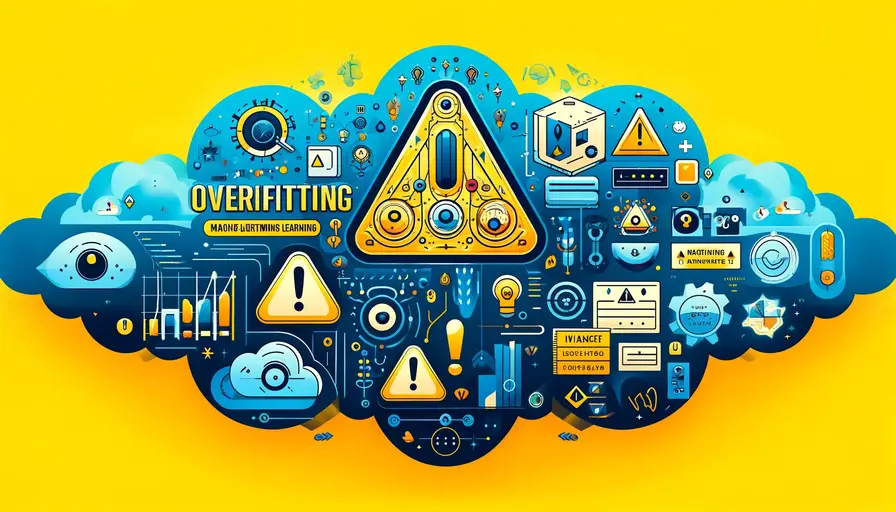
Overfitting: The Dangers for Machine Learning Students

In the world of machine learning, overfitting is a critical concept that every student must understand and navigate. Overfitting occurs when a model learns the details and noise in the training data to such an extent that it performs well on training data but poorly on unseen data. This article delves into the dangers of overfitting for machine learning students, providing insights into its causes, effects, and strategies to mitigate it. By mastering the balance between bias and variance, students can build robust models that generalize well to new data.
Understanding Overfitting
Definition and Causes of Overfitting
Overfitting is a phenomenon where a machine learning model captures the noise and outliers in the training data instead of learning the underlying patterns. This happens when the model is excessively complex, with too many parameters relative to the number of observations. As a result, the model becomes highly sensitive to the training data, leading to poor generalization on new, unseen data.
Several factors contribute to overfitting. One primary cause is having a model that is too complex for the available data. For instance, using a high-degree polynomial regression for a small dataset can cause the model to fit the noise rather than the signal. Additionally, insufficient training data can exacerbate overfitting, as the model lacks enough examples to learn general patterns.
Another common cause is the lack of regularization, which helps constrain the model's complexity. Regularization techniques such as L1 and L2 regularization add penalties to the model's parameters, discouraging it from fitting noise. Without regularization, models are more prone to overfitting, especially in high-dimensional spaces where many features are available.
Key Weaknesses of Machine Learning Decision Trees: Stay MindfulEffects of Overfitting
The effects of overfitting can be detrimental to the performance and reliability of a machine learning model. A key symptom is the discrepancy between training and test performance. An overfitted model will typically have high accuracy on the training set but low accuracy on the test set. This indicates that the model has memorized the training data rather than learning to generalize from it.
Overfitting can lead to misleadingly high performance metrics during training, giving a false sense of model capability. This can result in poor decision-making when the model is deployed in real-world applications. For instance, in predictive maintenance, an overfitted model might fail to identify potential failures in new equipment, leading to unexpected downtimes.
In addition to poor predictive performance, overfitting can also increase the computational cost of the model. More complex models require more resources for training and inference, making them less efficient. This is particularly problematic in applications where quick decision-making is crucial, such as real-time recommendations or autonomous driving.
Identifying Overfitting
Identifying overfitting involves comparing the model's performance on training and validation datasets. A significant gap between these performances suggests overfitting. Visualization techniques like learning curves can also help diagnose overfitting. A learning curve plots the model's performance against the training iterations, revealing whether the model improves on the training set but stagnates or degrades on the validation set.
High Bias in Machine Learning Models: Overfitting ConnectionAnother method is cross-validation, which involves partitioning the data into multiple subsets and training the model on different combinations of these subsets. Cross-validation provides a more reliable estimate of model performance on unseen data, helping to identify overfitting. Techniques like k-fold cross-validation are commonly used to assess the generalization capability of the model.
Example of using learning curves to identify overfitting in scikit-learn:
import numpy as np
import matplotlib.pyplot as plt
from sklearn.model_selection import learning_curve
from sklearn.linear_model import Ridge
# Generate synthetic data
X = np.linspace(0, 10, 100).reshape(-1, 1)
y = np.sin(X).ravel() + np.random.normal(0, 0.1, X.shape[0])
# Initialize the model
model = Ridge(alpha=1.0)
# Compute learning curves
train_sizes, train_scores, validation_scores = learning_curve(
model, X, y, train_sizes=np.linspace(0.1, 1.0, 10), cv=5, scoring='neg_mean_squared_error'
)
# Calculate mean and standard deviation for training and validation scores
train_scores_mean = np.mean(train_scores, axis=1)
train_scores_std = np.std(train_scores, axis=1)
validation_scores_mean = np.mean(validation_scores, axis=1)
validation_scores_std = np.std(validation_scores, axis=1)
# Plot learning curves
plt.figure()
plt.title("Learning Curves (Ridge Regression)")
plt.xlabel("Training examples")
plt.ylabel("Score")
plt.fill_between(train_sizes, train_scores_mean - train_scores_std, train_scores_mean + train_scores_std, alpha=0.1, color="r")
plt.fill_between(train_sizes, validation_scores_mean - validation_scores_std, validation_scores_mean + validation_scores_std, alpha=0.1, color="g")
plt.plot(train_sizes, train_scores_mean, 'o-', color="r", label="Training score")
plt.plot(train_sizes, validation_scores_mean, 'o-', color="g", label="Cross-validation score")
plt.legend(loc="best")
plt.show()Strategies to Prevent Overfitting
Regularization Techniques
Regularization is a powerful technique to prevent overfitting by adding a penalty to the model's complexity. L1 regularization (Lasso) adds a penalty equal to the absolute value of the coefficients, encouraging sparsity in the model. L2 regularization (Ridge) adds a penalty proportional to the square of the coefficients, discouraging large values.
Combining L1 and L2 regularization results in Elastic Net, which benefits from both techniques. Regularization can be easily implemented using libraries like scikit-learn. Regularization parameters, such as the regularization strength (alpha), can be tuned to balance the bias-variance tradeoff.
Biases on Accuracy in Machine Learning ModelsExample of applying L2 regularization using Ridge regression:
from sklearn.linear_model import Ridge
# Initialize the model with L2 regularization
model = Ridge(alpha=1.0)
# Train the model
model.fit(X_train, y_train)
# Make predictions
y_pred = model.predict(X_test)
print("Predictions with L2 Regularization:")
print(y_pred)Cross-Validation Techniques
Cross-validation techniques provide a robust way to assess model performance and detect overfitting. K-fold cross-validation splits the data into k subsets, trains the model on k-1 subsets, and validates it on the remaining subset. This process is repeated k times, and the performance metrics are averaged.
Stratified k-fold cross-validation ensures that each fold has a similar distribution of the target variable, which is crucial for imbalanced datasets. Leave-one-out cross-validation (LOOCV) uses each data point as a validation set once, providing an almost unbiased estimate of model performance.
Example of implementing k-fold cross-validation using scikit-learn:
from sklearn.model_selection import cross_val_score
from sklearn.linear_model import LogisticRegression
# Initialize the model
model = LogisticRegression()
# Perform k-fold cross-validation
k = 5
scores = cross_val_score(model, X, y, cv=k, scoring='accuracy')
print(f'{k}-Fold Cross-Validation Scores:')
print(scores)
print(f'Average Cross-Validation Score: {np.mean(scores)}')Data Augmentation and Early Stopping
Data augmentation involves increasing the diversity of the training data without collecting new data. Techniques such as adding noise, rotating, flipping, and scaling images can make the model more robust to variations. Data augmentation is commonly used in computer vision tasks and can be implemented using libraries like TensorFlow and Keras.
Early stopping is another effective technique to prevent overfitting. It involves monitoring the model's performance on a validation set and stopping the training process when performance starts to degrade. This prevents the model from overfitting the training data by limiting the training duration.
Example of applying data augmentation using Keras:
from keras.preprocessing.image import ImageDataGenerator
# Initialize the data generator with augmentation
datagen = ImageDataGenerator(
rotation_range=20,
width_shift_range=0.2,
height_shift_range=0.2,
shear_range=0.2,
zoom_range=0.2,
horizontal_flip=True,
fill_mode='nearest'
)
# Fit the generator to the training data
datagen.fit(X_train)
# Use the generator for training
model.fit(datagen.flow(X_train, y_train, batch_size=32), epochs=50, validation_data=(X_test, y_test), callbacks=[early_stopping])Practical Examples and Case Studies
Healthcare Applications
In healthcare, overfitting can have serious consequences, as models need to generalize well to new patients. For example, a model predicting disease outcomes must perform consistently across different patient populations. Overfitting can lead to incorrect diagnoses and treatment recommendations, impacting patient safety.
Overfitting in LSTM-based Deep Learning ModelsHealthcare datasets often have high dimensionality and small sample sizes, making regularization and cross-validation essential. Techniques such as dropout regularization in neural networks and data augmentation (e.g., synthetic generation of medical images) help improve model generalization.
Financial Modeling
In finance, models are used for risk assessment, fraud detection, and stock price prediction. Overfitting can result in poor investment decisions and financial losses. For instance, a model predicting stock prices based on historical data might overfit to market noise, leading to inaccurate predictions.
Regularization techniques and cross-validation are crucial in financial modeling to ensure robustness. Additionally, using ensemble methods like bagging and boosting can reduce the risk of overfitting by combining multiple models to improve overall performance.
Example of applying ensemble methods using scikit-learn:
from sklearn.ensemble import RandomForestClassifier
# Initialize the ensemble model
model = RandomForestClassifier(n_estimators=100, random_state=42)
# Train the model
model.fit(X_train, y_train)
# Make predictions
y_pred = model.predict(X_test)
print("Predictions with Ensemble Method (Random Forest):")
print(y_pred)Marketing Analytics
In marketing, machine learning models are used for customer segmentation, churn prediction, and campaign optimization. Overfitting can lead to inaccurate customer insights and ineffective marketing strategies. For instance, a churn prediction model that overfits might fail to identify at-risk customers accurately.
To prevent overfitting, marketers can use regularization, cross-validation, and data augmentation techniques. Ensuring a diverse training dataset that represents various customer segments is also critical. By maintaining a balance between model complexity and generalization, marketers can derive actionable insights and improve customer engagement.
Advanced Techniques to Address Overfitting
Ensemble Learning
Ensemble learning combines multiple models to improve overall performance and robustness. Techniques such as bagging, boosting, and stacking create a diverse set of models and aggregate their predictions. Bagging, or Bootstrap Aggregating, reduces variance by training multiple models on different subsets of the data. Boosting sequentially trains models, with each model correcting the errors of the previous one.
Stacking involves training a meta-model on the predictions of multiple base models, improving predictive accuracy. Ensemble methods are highly effective in reducing overfitting and enhancing model generalization.
Example of applying boosting using XGBoost:
import xgboost as xgb
# Initialize the XGBoost model
model = xgb.XGBClassifier(n_estimators=100, learning_rate=0.1, random_state=42)
# Train the model
model.fit(X_train, y_train)
# Make predictions
y_pred = model.predict(X_test)
print("Predictions with Boosting (XGBoost):")
print(y_pred)Dimensionality Reduction
High-dimensional datasets are prone to overfitting, as models can easily capture noise. Dimensionality reduction techniques such as Principal Component Analysis (PCA) and t-SNE reduce the number of features while preserving important information. These techniques simplify the model, making it less likely to overfit.
PCA transforms the data into a set of linearly uncorrelated components, ordered by the amount of variance they explain. t-SNE is a non-linear technique that visualizes high-dimensional data in a lower-dimensional space, often used for exploratory data analysis.
Example of applying PCA using scikit-learn:
from sklearn.decomposition import PCA
# Initialize PCA and reduce dimensionality
pca = PCA(n_components=2)
X_reduced = pca.fit_transform(X)
print("Reduced Dimensions:")
print(X_reduced)Transfer Learning
Transfer learning leverages pre-trained models on similar tasks, reducing the need for large training datasets. This technique is especially useful in fields like computer vision and natural language processing, where labeled data is scarce. By fine-tuning a pre-trained model on the target task, transfer learning achieves high performance with less risk of overfitting.
Pre-trained models such as ResNet, BERT, and GPT have demonstrated success in various applications. Fine-tuning these models on specific tasks involves adjusting the final layers while keeping the core architecture intact.
Example of applying transfer learning using Keras with a pre-trained ResNet model:
from keras.applications import ResNet50
from keras.models import Model
from keras.layers import Dense, Flatten
# Load the pre-trained ResNet model
base_model = ResNet50(weights='imagenet', include_top=False, input_shape=(224, 224, 3))
# Add custom layers on top of the base model
x = base_model.output
x = Flatten()(x)
x = Dense(1024, activation='relu')(x)
predictions = Dense(10, activation='softmax')(x)
# Create the final model
model = Model(inputs=base_model.input, outputs=predictions)
# Freeze the layers of the base model
for layer in base_model.layers:
layer.trainable = False
# Compile and train the model
model.compile(optimizer='adam', loss='categorical_crossentropy', metrics=['accuracy'])
model.fit(X_train, y_train, epochs=10, validation_data=(X_test, y_test))
print("Model with Transfer Learning:")
print(model.summary())By understanding the dangers of overfitting and implementing strategies to prevent it, machine learning students can develop robust models that generalize well to new data. Balancing model complexity with generalization, using advanced techniques such as ensemble learning, dimensionality reduction, and transfer learning, and continuously validating models with techniques like cross-validation are essential practices in building effective machine learning solutions.
If you want to read more articles similar to Overfitting: The Dangers for Machine Learning Students, you can visit the Bias and Overfitting category.



You Must Read